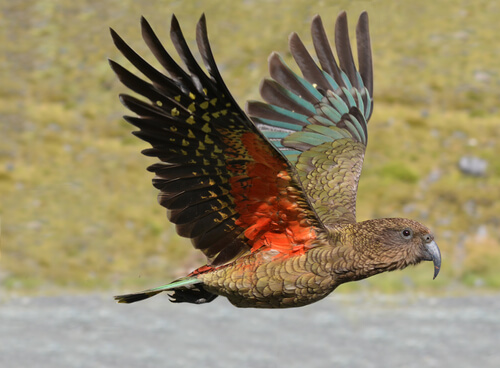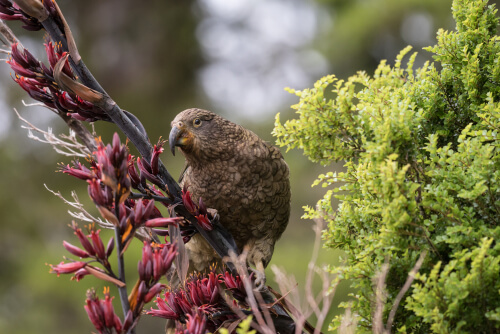The Kea: The Parrot with a Hunger for Knowledge

The Kea parrot, or Nestor notabilis, is part of the Nestoridae family, of which there are only two species. Both are endemic to New Zealand; the other one is the Nestor meridionalis known as the kaka.
It is now known that keas require high standards of enrichment and socialization. For this reason, information obtained from studies using captive birds can be important in understanding the wild traits of this species.
How do you recognize the Kea?

These parrots reach the size of a crow, about 48 centimeters (19 inches) long as adults. As for the plumage, the head and underparts are brownish-green with blackish edges. The underwings are orange-red with yellow stripes and notches.
Reproduction and behavior of the Kea parrot
Juveniles form flocks of up to 20 individuals, while adults pair for life, forming family groups and occasionally joining larger groups at feeding sites.
Hierarchical reproduction
In this species, males fight for dominance and the hierarchy is strict. Thus, in certain years only 10% of the males are able to reproduce. It has been observed that the kea breeds at all times of the year, except in late autumn. The male feeds the chicks for up to six weeks. The juveniles then disperse from their natal area and travel together in flocks for two to three years before settling down.
Fearless explorers
Keas are very intelligent and social birds. Their climatically hostile environment and low risk of predators are thought to have caused the exploratory and curious nature of the Nestor notabilis. It’s common for congregations of 30 to 40 birds to break into feeding sites together, such as garbage dumps.
They have strict lines of command
These birds have remarkable dominance hierarchies. In experiments on cooperation, it has been determined that dominant individuals can force subordinates to cooperate on tasks. This is even the case if the outcome only benefits the dominant birds.
The kea and its hunger for knowledge
Animal innovations are key to the survival and evolution of species. Scientists define animal innovation, or neophilia, as the process that generates newly-learned behavior in an individual – behavior that isn’t a consequence of social learning or environmental induction. The importance of this is that such behavior allows the animal to use new resources and, therefore, to make better use of its environment.
In this sense, it has been proposed that life in the extreme alpine environment has encouraged the kea to explore its surroundings opportunistically. Thus, various innovative behaviors are associated with the neophilic nature of this bird:
- Patent curiosity towards humans and ski equipment
- Chewing the rubber parts of cars left in parking lots
- Opening the lids of garbage containers to obtain food scraps
Neophilia is a well-studied area of ornithology, as a large number of bird species tend to be very exploratory. Progressively, this ability is becoming more important given the impact humans are having on the environment and the changes we are making to the species’ natural habitat.
Innovative behaviors tend to emerge from individuals that are dominant and good explorers.
The intelligence of the kea parrot
Recently, it has been suggested that some birds (in particular the order Psittaciformes and the family Corvidae) may have intelligence equivalent to primates.
It should be noted that comparing the intelligence of different species is a difficult task for several reasons. In the first place, it is almost impossible to design one single test that satisfies the cognitive demands of a diverse set of species. Still, several studies are advancing this knowledge.
Brain size
There is experimental evidence that Nestor notabilis have relatively large brains compared to other non-passerine birds, and that the size is similar to those of the family Corvidae.
Cognitive abilities

Cognitive abilities may evolve due to environmental problems faced by a species that require specialized skills to solve.
- Spatial memory and food storage: The ability to store food for a later time is common in many bird species.
- Social learning: A study examining social learning with respect to problem solving shows that young birds learn new skills from older, innovative individuals in the group.
- Tool use: New Caledonian crows are perhaps the best-known tool-using species, and have demonstrated this ability in many studies. One of the most notable tests involved a crow that was able to bend a straight wire into a hook to retrieve a bucket of food that had been placed in a pipe. Nestor notabilis, although not a tool-using species in the wild, has demonstrated successful use of tools in research experiments.
- Problem-solving: Nestor notabilis is particularly known for its ability to solve problems, a trait that may have arisen from its constantly changing alpine environment.
All cited sources were thoroughly reviewed by our team to ensure their quality, reliability, currency, and validity. The bibliography of this article was considered reliable and of academic or scientific accuracy.
- Emery, N. J. (2006). Cognitive ornithology: the evolution of avian intelligence. Philosophical Transactions of the Royal Society B-Biological Sciences, 361(1465), 23-43. doi:10.1098/rstb.2005.1736
- Huber, L., Rechberger, S., & Taborsky, M. (2001). Social learning affects object exploration and manipulation in keas, Nestor notabilis. Animal Behaviour, 62, 945-954. doi:10.1006/anbe.2001.1822
- Auersperg, A. M. I., von Bayern, A. M. P., Gajdon, G. K., Huber, L., & Kacelnik, A. (2011). Flexibility in problem solving and tool use of kea and New Caledonian crows in a multi access box paradigm. Plos One, 6(6): e20231.doi:10.1371/journal.pone.0020231
This text is provided for informational purposes only and does not replace consultation with a professional. If in doubt, consult your specialist.